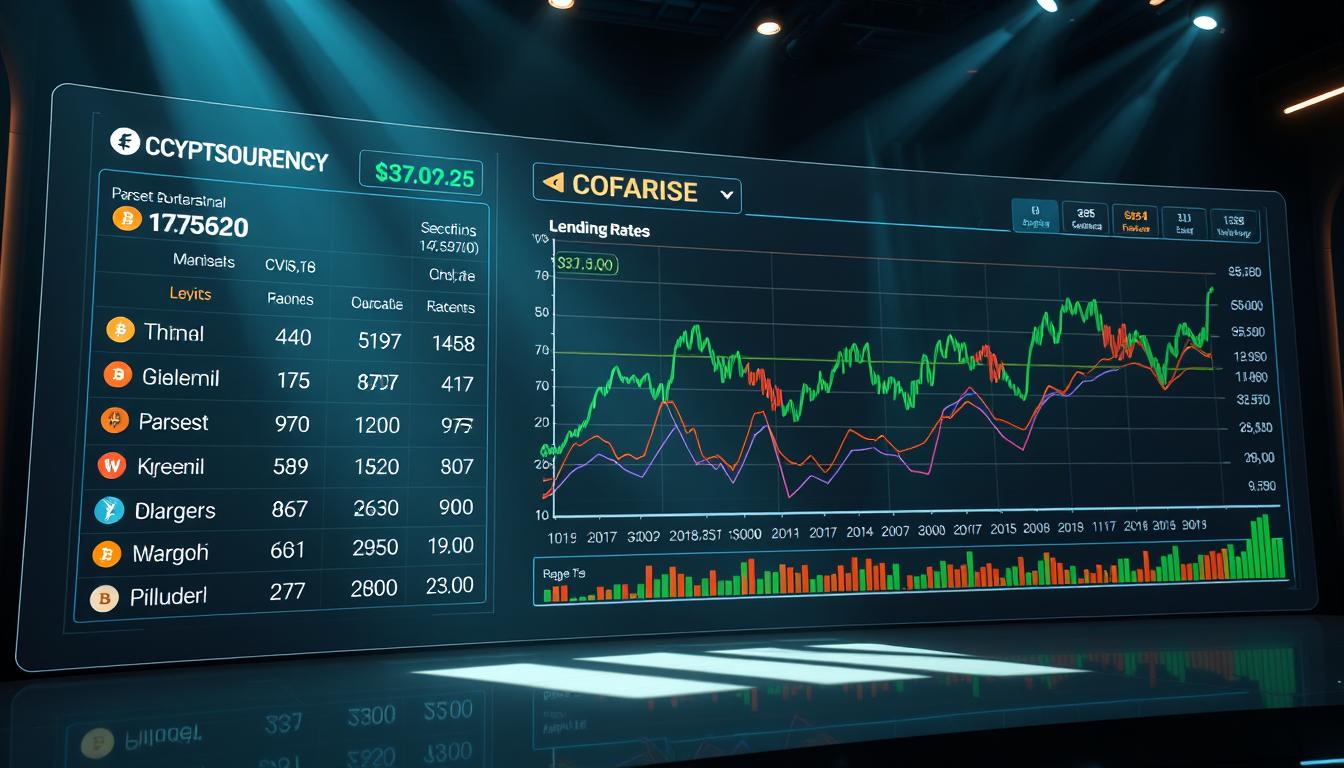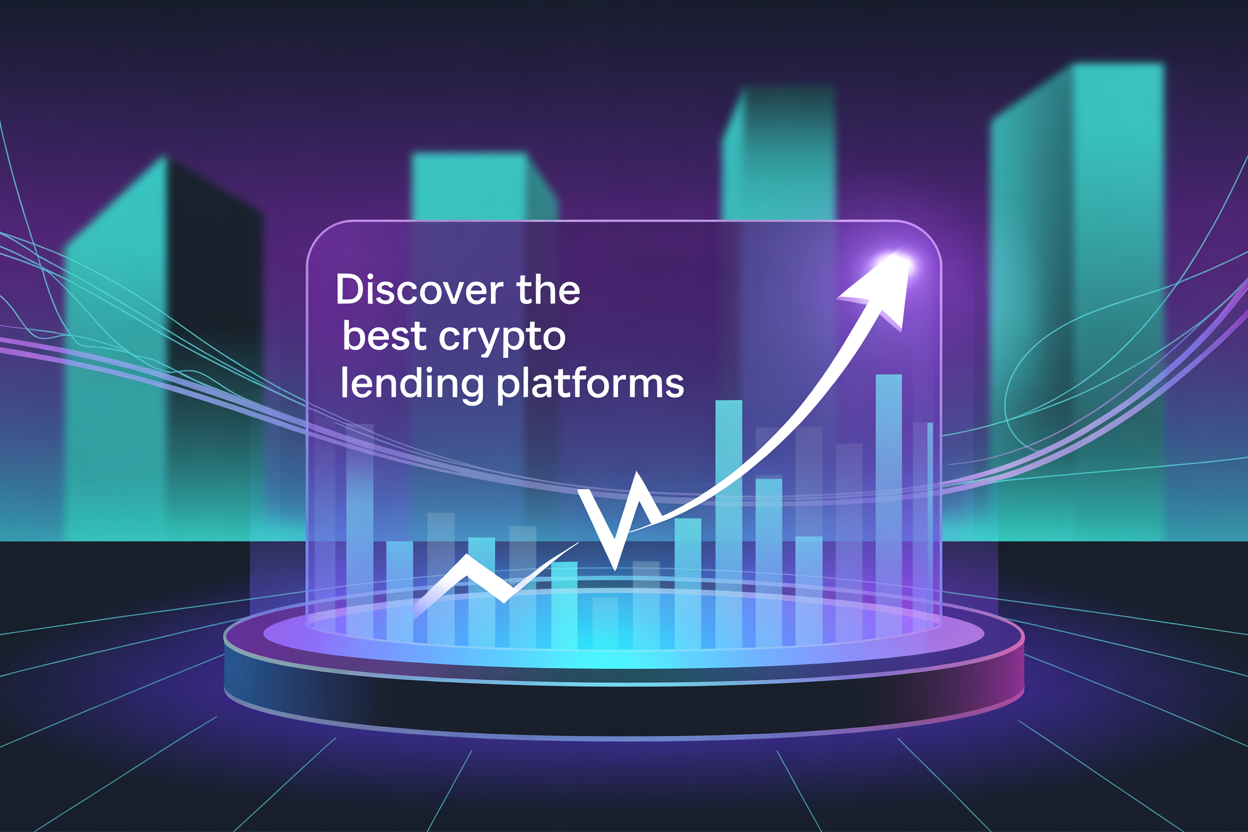Now Reading: Crypto Lending Rates Comparison: Find the Best
- 01
Crypto Lending Rates Comparison: Find the Best
Crypto Lending Rates Comparison: Find the Best

Exploring digital asset lending can be tricky. Many platforms have different interest rates. It’s important to compare these rates to get the most from your investments.

As crypto lending platforms grow, so do your options. But, the rates can change how much you earn.
Knowing how to compare these rates is vital. This article will help you find the best crypto lending rates out there.
Key Takeaways
- Comparing lending rates is crucial for maximizing investment returns.
- Different platforms offer varying interest rates for digital assets.
- Understanding the terms and conditions of lending platforms is essential.
- The best lending rates can significantly impact your overall earnings.
- Researching and comparing rates can lead to better investment decisions.
Understanding Crypto Lending
Crypto lending platforms have changed how we lend and borrow online. As the crypto market grows, it’s key for investors to grasp crypto lending basics. This knowledge helps them get the most from their investments.
What is Crypto Lending?
Crypto lending means lending cryptocurrencies to others who use other digital assets as collateral. This way, lenders can earn interest on their crypto, creating a steady income. Crypto lending rates comparison is vital to find the best returns.
How Crypto Lending Works
Crypto lending is simple. Lenders put their crypto on a lending platform. Borrowers then use this crypto as collateral, often with more assets than they borrow. The platform handles the transaction, manages the collateral, and splits the interest with lenders.
Borrower and Lender Dynamics
The relationship between borrowers and lenders is set by the platform’s rules. Lenders want to earn as much interest as possible. Borrowers try to keep their costs low. Knowing these goals helps both sides make better choices.
Collateralization Requirements
Collateral is crucial in crypto lending to protect lenders. Borrowers must offer assets worth more than the loan. This ensures lenders can get their money back if the borrower can’t pay. The collateralization ratio varies and affects the safety and appeal of lending options.
Why Crypto Lending Rates Matter
Crypto lending rates are key to making money from lending out cryptocurrencies. As the crypto lending market grows, knowing about these rates is vital for investors. It helps them get the most from their investments.
Impact on Investment Returns
The interest rates from crypto lending platforms affect your investment returns. Higher lending rates can greatly increase your earnings. It’s important to look at rates from different platforms. For example, lending Bitcoin or Ethereum at a rate 1% higher than average can add up to a lot of money over time.
- Higher lending rates increase potential earnings.
- Comparing rates across platforms is crucial.
- Even small rate differences can have a significant impact.
Opportunity Cost Considerations
When you lend cryptocurrencies, think about the opportunity cost. Lending at a low rate might not be as good as other investments, like staking or yield farming. So, it’s important to look at the best crypto lending rates in the context of your investment plan.
Calculating Potential Earnings
To figure out your potential earnings, consider the principal amount, the lending rate, and how long the loan is. Online calculators or spreadsheets can make this easier. They help you make smart choices.
Comparing to Traditional Finance Options
Crypto lending rates often beat traditional finance options, especially when interest rates are low. For example, lending stablecoins can give you higher returns than traditional savings accounts. But, it’s important to think about the risks of crypto lending, like platform risk and cryptocurrency price changes.
Understanding why crypto lending rates matter helps you make better investment choices. This way, you can potentially increase your returns.
Types of Crypto Lending Platforms
The crypto lending world offers many platforms for different needs. Investors can pick from various types, each with its own benefits and features.
Centralized Finance (CeFi) Platforms
Centralized Finance (CeFi) platforms connect lenders with borrowers. They offer a traditional feel for crypto lending. CeFi platforms are easy for new users to use because they’re familiar.
BlockFi and Celsius Network are popular for their good rates and strong security.
Decentralized Finance (DeFi) Protocols
Decentralized Finance (DeFi) protocols use blockchain for peer-to-peer lending. They’re open and transparent, with all transactions recorded on public blockchains. DeFi protocols often have higher interest rates than banks, attracting lenders.
However, they can be complex and riskier because they lack central control. Aave and Compound are well-known DeFi platforms.
Hybrid Lending Solutions
Hybrid platforms mix CeFi and DeFi features. They offer the ease and security of CeFi with the openness and potential for high returns of DeFi. Hybrid solutions aim to meet the varied needs of crypto investors, providing flexibility and a wide range of services.

When choosing a crypto loan provider, consider the platform type and its mechanics. Whether it’s CeFi, DeFi, or hybrid, knowing the platform’s features and risks is key. A crypto lending rate aggregator can help compare rates across platforms efficiently.
Factors Affecting Crypto Lending Rates
It’s key to know what affects crypto lending rates. This knowledge helps in making smart choices in the crypto lending world. Several things play a part in setting these rates, affecting both lenders and borrowers.
Market Demand and Supply
The demand for borrowing crypto and the amount available to lend greatly shape lending rates. When demand is high and there’s not much to lend, rates go up. On the flip side, if demand is low and there’s plenty to lend, rates drop. This is similar to how interest rates work in traditional finance, based on credit demand and available funds.
Platform Risk Profiles
Each lending platform has its own risk level, shown in their rates. Platforms that are very careful and secure might offer better rates because they’re less risky. But, platforms with higher risks might charge more to make up for the risk of defaults or security issues.
Cryptocurrency Volatility
The volatility of the crypto being lent or borrowed is also a big factor. Cryptos that are more volatile are seen as riskier, leading to higher rates. Stablecoins, being more stable, usually have lower rates because they’re less risky.
Lock-up Periods and Terms
The length of time assets are locked up affects rates too. Longer lock-ups might mean higher rates because they make it harder for lenders to get their assets back. Options that let you withdraw early might have lower rates or penalties for early withdrawal.
In summary, crypto lending rates are shaped by many factors. These include market forces, platform features, and the crypto’s own characteristics. Knowing these can help lenders make better choices and possibly earn more.
Top CeFi Platforms and Their Rates
CeFi platforms are known for their reliability and attractive lending rates. They are popular among investors looking to grow their digital assets. This section will explore some top CeFi platforms, looking at their rates, features, and terms.
Nexo
Nexo is a leading CeFi platform with competitive rates and flexible terms. It supports many cryptocurrencies, making it a good choice for lenders.
Rate Structure and Loyalty Tiers
Nexo rewards loyalty with higher interest rates for bigger deposits and longer terms. Their loyalty tiers offer more benefits, like higher interest rates and lower fees.
Supported Assets
Nexo supports over 40 cryptocurrencies, including Bitcoin and Ethereum. This variety lets users lend different digital assets.
BlockFi
BlockFi is a well-known CeFi platform with a user-friendly interface and good interest rates. It offers various lending products for different investors.
Interest Account Details
BlockFi’s Interest Account lets users earn interest on their crypto. It has competitive interest rates and flexible withdrawals.
Rate Caps and Limitations
BlockFi has attractive rates but also caps and limits, especially for big accounts. Knowing these is key to getting the most returns.
Celsius Network
Celsius Network focuses on transparency and user benefits. It offers competitive rates and a unique rewards program.
Reward Rates and Token Benefits
Celsius rewards users with its native token, CEL. This offers benefits like boosted interest rates and lower fees for token holders.
Withdrawal Policies
Celsius allows flexible withdrawals but with certain conditions. It’s important to understand these policies for managing your money.
Gemini Earn
Gemini Earn is a lending program from the Gemini exchange. It’s known for regulatory compliance and secure lending. It offers competitive rates for a few cryptocurrencies.
Crypto.com
Crypto.com offers a lending service as part of its crypto product ecosystem. It has competitive rates and is easy to use, especially for Crypto.com users.
When comparing CeFi platforms, look at rates, terms, supported assets, and features. This helps find the best platform for your needs and to maximize your crypto lending returns.
Leading DeFi Protocols for Lending
In the world of DeFi, lending protocols are key. Aave, Compound, MakerDAO, and Curve Finance lead the way. They change how we lend and borrow cryptocurrencies, offering many benefits and chances.
Aave
Aave is a top DeFi lending platform. It’s known for its flexibility and new features. Users can lend and borrow different cryptocurrencies.
Variable vs. Stable Rate Options
Aave has both variable and stable interest rates. This lets lenders and borrowers pick what suits them best. Variable rates can be more lucrative when demand is low, while stable rates are more predictable.
Liquidity Mining Incentives
Aave rewards liquidity providers with AAVE tokens. This boosts participation and liquidity in the protocol.
Compound
Compound is a well-known DeFi lending platform. It lets users lend and borrow assets. It’s known for being transparent and autonomous, run by its native COMP token holders.
Interest Model and COMP Distribution
Compound’s interest rates are set by an algorithm, based on supply and demand. COMP token holders get rewards for lending or borrowing.
Governance Participation
COMP token holders can vote on changes to the protocol. This ensures the protocol grows based on community needs.
MakerDAO
MakerDAO is a decentralized lending platform. It lets users borrow DAI, a stablecoin, against assets. It’s known for its strong governance and stability.
Curve Finance
Curve Finance focuses on stablecoin lending and borrowing. It offers low-slippage swaps and competitive rates. It’s great for lending or borrowing stablecoins.
When comparing these DeFi lending protocols, look at interest rates, liquidity, and governance. Knowing each protocol’s unique features helps users decide where to lend or borrow cryptocurrencies.
Crypto Lending Rates Comparison Methodology
It’s important to know how to compare crypto lending rates. With more platforms available, it’s getting more complex. This section will help you understand how to compare rates effectively.
APY vs. APR Explained
When looking at crypto lending rates, you’ll see APY and APR. APY includes compounding interest, giving a clearer view of your earnings. APR shows the interest rate without compounding. Knowing the difference helps you compare rates better.
Fixed vs. Variable Rates
Platforms offer fixed or variable interest rates. Fixed rates stay the same, making it easier to plan. Variable rates change with the market, offering more risk but possibly higher returns. For example, Galaxy Research found some platforms adjust rates based on demand and supply.
Compounding Frequency Impact
How often interest is compounded greatly affects your earnings. It can be daily, weekly, or monthly. More frequent compounding means higher returns over time.
Daily vs. Weekly vs. Monthly Compounding
Daily compounding gives more returns than monthly because interest is applied more often. Here’s a quick comparison:
- Daily Compounding: More frequent, potentially higher returns
- Weekly Compounding: Moderate frequency
- Monthly Compounding: Less frequent, potentially lower returns compared to daily or weekly
Calculating Effective Annual Yield
To compare rates accurately, calculate the Effective Annual Yield (EAY). It considers compounding frequency. The formula is: EAY = (1 + r/n)^(n) – 1, where r is the interest rate and n is the compounding periods per year.
By grasping these methods, you can make better choices when comparing crypto lending rates. This helps you find the best rates for your investments.
Step-by-Step Guide to Compare Lending Rates
There are many lending platforms out there. It’s key to compare cryptocurrency lending rates to improve your investment strategy. This guide will walk you through the essential steps to make smart choices and boost your returns.
Step 1: Identify Your Lending Goals
First, figure out what you want from lending. Are you after quick profits or steady growth? Knowing your goals will help you pick the right platforms and cryptocurrencies.
Step 2: Research Platform Reputations
It’s important to check the reputation of lending platforms. Look at their security, user feedback, and past performance. This will tell you if they’re trustworthy.
Step 3: Use Rate Aggregators and Tools
Rate aggregators and comparison tools make comparing easier. They give you a clear view of rates across platforms. This helps you spot the best deals.
Step 4: Create a Comparison Spreadsheet
Make a spreadsheet to organize your data. This is a crucial step for making a smart choice.
Essential Metrics to Track
In your spreadsheet, track important metrics like APY, APR, and how often interest compounds. These affect your earnings a lot.
Decision Matrix Template
A decision matrix template can help too. It lets you weigh factors like security, reputation, and rates. This way, you can pick the platform that fits your goals best.
By following these steps, you can effectively compare cryptocurrency lending rates. This will help you make informed decisions and increase your investment returns.
Cryptocurrency-Specific Lending Rates
The world of cryptocurrency lending is vast and varied. Different assets offer unique lending opportunities. It’s key to understand the rates for specific cryptocurrencies.
Bitcoin (BTC) Lending Rates
Bitcoin is the most recognized cryptocurrency. It often has competitive lending rates. Platforms like BlockFi and Celsius Network offer BTC lending rates up to 4-5% APY.
These rates are attractive for lenders. They can earn a steady income from their Bitcoin holdings.
Ethereum (ETH) Lending Rates
Ethereum lending rates are also competitive. Some platforms offer rates up to 4% APY. The rates vary based on the platform and market conditions.
For example, Nexo and Crypto.com offer ETH lending options with competitive rates.
Stablecoin Lending Rates
Stablecoins like USDC, USDT, and DAI are popular for lending. Their stable nature makes them attractive. Lending rates for stablecoins range from 5-12% APY, depending on the platform and market demand.
USDC and USDT Comparisons
USDC and USDT are widely used stablecoins. Lending rates for USDC can reach up to 10% APY on platforms like Compound. USDT lending rates can go up to 12% APY on certain DeFi protocols.
DAI and Other Decentralized Stablecoins
DAI, a decentralized stablecoin, offers competitive lending rates. On MakerDAO, DAI lending rates are around 6-8% APY. Other decentralized stablecoins may offer similar or higher rates, depending on the platform and market conditions.
Altcoin Lending Opportunities
Altcoins offer higher lending rates than major assets like Bitcoin and Ethereum. However, they also come with higher risks. Platforms like Celsius Network and Nexo offer lending options for various altcoins, with rates higher than major cryptocurrencies.
When exploring altcoin lending opportunities, it’s crucial to assess the risks and potential returns carefully. Some altcoins may offer lending rates as high as 15-20% APY. But these come with increased volatility and risk.

To find the best crypto lending rates, compare rates across different platforms. Consider factors like platform reputation, security, and market conditions. By doing so, lenders can maximize their returns while minimizing risks.
Security Considerations When Lending Crypto
The crypto lending market is growing fast. This means it’s more important than ever to have strong security. Lenders need to watch out for risks to keep their assets safe.
Platform Insurance and Custody Solutions
Insurance and custody solutions are key for security. Top platforms offer strong custody and insurance. This protects against hacks and other security issues.
Many use cold storage for most assets. This greatly lowers the chance of theft.
Smart Contract Risks and Audits
Smart contract risks are big for DeFi lending. These protocols use smart contracts for lending and borrowing. To lower risks, many platforms get smart contract audits.
These audits find vulnerabilities. They make sure contracts work right and are secure.
Regulatory Compliance Checks
Following regulations is vital for security. Lenders must check if platforms follow the rules. This includes looking for licenses and following AML and KYC rules.
KYC Requirements by Platform
KYC rules vary by platform. Some need a lot of verification, while others are more relaxed. It’s important to know these rules to follow the platform’s rules.
Jurisdictional Restrictions
Lenders should know about restrictions by country. Some platforms can’t be used in certain places because of laws. Always check if a platform is available in your area before investing.
By looking at these security points, lenders can make better choices. Using a crypto lending rate aggregator helps compare rates. This ensures lenders find safe and good options.
Tax Implications of Crypto Lending
When it comes to crypto lending, taxes are a big deal. It’s important to know the tax rules to make the most of your investments. This knowledge helps with following the law and planning your finances.
Interest Income Taxation in the US
In the US, the IRS sees crypto lending rewards as taxable income. This means you have to report the interest you earn from lending on your taxes. The taxation of interest income covers both fiat and crypto earnings. It’s key to remember that you must report all income from lending, including the principal and interest.
For example, if you lent crypto and got interest in more crypto, that interest is taxable. You must report it at its USD value on the day you got it.
Record-Keeping Best Practices
Keeping good records is vital for tax compliance with crypto lending. You should document all transactions, such as:
- Lending dates and amounts
- Interest earned
- Transaction IDs
- Wallet addresses used
Good record-keeping helps in figuring out gains and losses. It also makes filling out tax forms easier.
Working with Crypto Tax Professionals
Dealing with crypto taxes can be tricky. That’s why getting help from a crypto tax professional is a smart move. They know the tax laws for crypto, including lending. They can help with reporting income, claiming deductions, and handling tax issues with lent cryptocurrencies.
Understanding taxes and keeping good records helps you follow the law. It also helps you get the most out of your crypto lending.
Maximizing Your Crypto Lending Returns
To get the most from crypto lending, you need to know the market, plan smartly, and pick the right platform. It’s all about finding the best rates and understanding the platforms.
Rate Hunting Strategies
Looking for the best rates is key. Here’s how to do it:
- Keep an eye on different platforms for top rates
- Know what each rate means and what’s included
- Stay on top of market trends that can change rates
Promotional Rate Opportunities
Many sites offer special rates to draw in new users or to encourage lending. These deals can give you significantly higher returns for a short time. Keep an eye out for these offers.
Platform-Hopping Considerations
When you’re looking for the best rates, think about the risks of switching platforms. Consider fees, minimums, and how they affect your earnings.
Portfolio Diversification Across Platforms
Spreading your lending across several platforms can lower risks and boost earnings. It helps in:
- Lessening the risk tied to one platform
- Grabbing different rate deals
- Making your portfolio stronger

Timing Market Cycles for Better Rates
Knowing when to lend based on market trends can lead to better rates. This way, you can get better rates and increase your earnings.
To find the best crypto lending rates, stay updated on market and platform changes. Use rate hunting, diversify, and time your lending right to get the most out of crypto lending.
Making Informed Decisions: Your Crypto Lending Strategy
Exploring crypto lending shows how important smart choices are for good returns. Knowing about different platforms, rate factors, and security is key. This helps you craft a solid crypto lending plan.
When looking at crypto lending rates, use rate aggregators to help. Comparing rates on platforms like Nexo, BlockFi, and Aave is essential. It helps you find the best spot for your money.
To improve your crypto lending strategy, spread your investments across platforms. Keep up with market trends too. This way, you can handle crypto lending’s challenges better. A smart approach to rates will help you reach your financial goals, whether with Bitcoin, Ethereum, or other coins.
Stay updated and adjust to crypto lending’s changes. This way, you can effectively compare rates and make smart choices. These choices will boost your investment success.
FAQ
What is the difference between APY and APR in crypto lending?
APY (Annual Percentage Yield) includes compounding interest. APR (Annual Percentage Rate) does not. In crypto lending, APY gives a clearer view of your earnings.
How do I compare cryptocurrency lending rates across different platforms?
Use rate aggregators and comparison tools to compare rates. Look at platform reputation, supported assets, and loan terms too.
What are the risks associated with lending cryptocurrencies?
Risks include platform risk, borrower default, and market volatility. Choose reputable platforms and diversify your lending. Stay updated on market conditions.
Can I lend any cryptocurrency, or are there specific assets that are more suitable?
Many platforms let you lend various cryptocurrencies. But, some assets like Bitcoin and stablecoins are more in demand. Their liquidity and demand affect their suitability for lending.
How do I ensure the security of my cryptocurrencies when lending?
Pick platforms with strong security, like insurance and cold storage. Also, check their regulatory compliance and KYC requirements.
Are there any tax implications I should be aware of when lending cryptocurrencies?
Yes, there are tax implications. In the US, interest from lending is taxable income. Keep accurate records and consult a crypto tax expert.
What is the impact of compounding frequency on my lending returns?
Compounding frequency greatly affects your returns. Daily compounding can lead to higher earnings than monthly compounding. Know the compounding frequency of your platform.
How can I maximize my crypto lending returns?
To boost your returns, try rate hunting and diversify your portfolio. Time your lending to market cycles. Stay informed and adjust your strategy for better returns.














